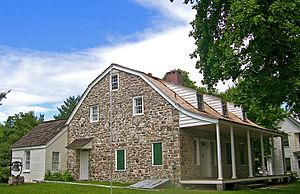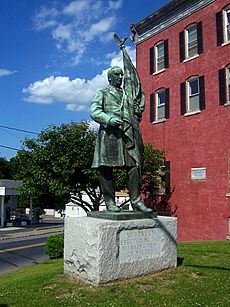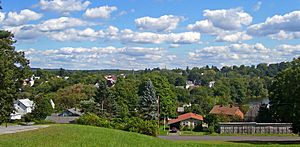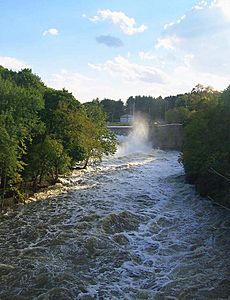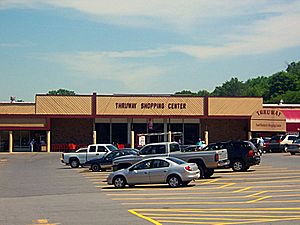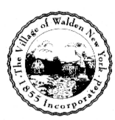Walden, New York facts for kids
Quick facts for kids
Walden
|
||
|---|---|---|
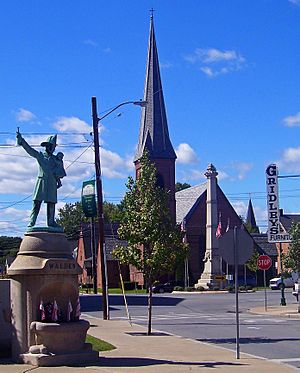
Central Walden, with memorials and St. Andrew's Episcopal Church, in 2007
|
||
|
||
| Etymology: From Jacob T. Walden | ||

Location in Orange County and the state of New York.
|
||
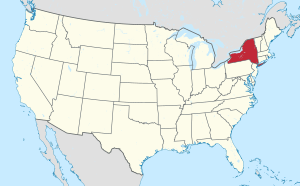
Location of New York in the United States
|
||
| Country | United States | |
| State | New York | |
| County | Orange | |
| Town | Montgomery | |
| Government | ||
| • Body | Village board | |
| Area | ||
| • Total | 2.08 sq mi (5.40 km2) | |
| • Land | 2.01 sq mi (5.20 km2) | |
| • Water | 0.07 sq mi (0.19 km2) | |
| Elevation | 260 ft (80 m) | |
| Population
(2020)
|
||
| • Total | 6,818 | |
| • Density | 3,393.73/sq mi (1,310.43/km2) | |
| Time zone | UTC−5 (Eastern) | |
| • Summer (DST) | UTC−4 (Eastern Daylight Time) | |
| ZIP Code |
12586
|
|
| Area code(s) | 845 | |
| Exchanges | 778, 787 | |
| FIPS code | 36-77849 | |
| Website | www.villageofwalden.org | |
Walden is a village in Orange County, New York, United States. It is the largest of three villages in the town of Montgomery. In 2020, about 6,818 people lived there. Walden is known for its history as a mill town and later for making knives. It is part of a larger metropolitan area that includes New York and Newark.
Contents
History of Walden Village
Europeans first came to the Walden area around the 1650s. They started building permanent homes in the early 1700s. In 1736, Alexander Kidd bought the land where Walden is today. Soon after, settlers from Scotland, Ireland, England, and Germany arrived. This first settlement west of the Wallkill River was called Kidd's Town.
In 1813, a businessman named Jacob Treadwell Walden from New York City bought land along the Wallkill River. He wanted to build factories there. He convinced his business partners to help build wool mills. The Great Falls on the river provided power, and nearby Maybrook had railroad connections.
Jacob Walden built a dam above the falls, which is still used today for power. His mill was very successful. By the 1820s, his mill made a lot of cotton and woolen cloth. As more wool factories opened, the area became known as Walden's Mills. By the 1840s, it was a major center for wool products.
In 1855, Walden officially became a village.
Walden's Knife-Making Era
After a few decades, most of Walden's wool factories closed. The village looked for new industries. They encouraged knife makers from nearby Dutchess County to move into the empty mills. In 1856, the New York Knife Company moved to Walden. This company made many of the knives used by the Union Army during the U.S. Civil War.
After the war, more knife makers came to Walden. The Walden Knife Company opened in the 1870s. Schrade Cutlery built a factory in Walden in 1904. Because of all the knife factories, the village was sometimes called "Little Sheffield" or "Knifetown." Train service also came to Walden, making it easier to transport goods and people. Other factories, making things like engines and women's clothing, also opened.
In the early 1890s, President Grover Cleveland lowered taxes on imported goods, including knives. This meant cheaper German knives came into the American market. This, along with an economic slowdown, made it hard for the knife companies.
However, in 1897, President William McKinley helped the knife makers. He brought back the old taxes on imported goods. The knife companies became profitable again and paid off their debts. To show thanks, Thomas Wilson Bradley of the U.S. Knife Company had a statue of McKinley built, which you can still see in Walden today.
Walden grew a lot in the early 1900s. The downtown area developed with shops and homes above them. Many single-family homes were also built. During this time, many government buildings were constructed. By the 1910s, the dam was mostly used to create power, not just for factories.
Walden's Main Street was a busy shopping area. Stores like Millspaugh's Furniture and Roosa's Jewelers are still in business today. Lustig's Department Store was a main store on Main Street from 1883 until it closed in 1986.
The Great Depression was tough on many businesses, but the knife makers kept going. After World War II, they became less important. They moved as trucking on new Interstate Highways replaced trains. In 1957, Schrade Cutlery closed its Walden factory and moved. It was the last knife company in the village. The old factory ruins are still there.
Besides knives, Walden was also a center for the garment industry from the 1930s to the 1950s. As more people used cars in the late 1900s, downtown businesses found it hard to compete with larger shopping centers.
From 1995 to 2016, Walden was the main office for the Big Apple Circus.
Geography of Walden
Walden is about 2 square miles (5.4 square kilometers) in total area. Most of it is land, with a small amount of water.
The most important natural feature is the Wallkill River. It flows from south to north through the village, dividing it. Tin Brook, a smaller stream that flows into the Wallkill, also runs through the village. There are two waterfalls and dams on the river in Walden, called the Great and Little Falls. There are also two bridges over the river for cars.
The Wallkill River flows through a small gorge between the two dams. The land around Walden has gentle rolling hills. You can see the Shawangunk Ridge to the west and the Hudson Highlands to the southeast from some parts of the village. The highest point in Walden is about 520 feet (158 meters) above sea level. The lowest point is about 260 feet (79 meters) along the Wallkill River.
Walden first grew near the mills and knife factories. Today, the main business area is a few blocks east of the river, along Main Street. The village hall and main square are just south of Main Street. East Main Street has many newer businesses, including a small shopping area. There are also some businesses along Orange Avenue.
On the south side of the village is the Fox Hill Bruderhof Community. About 250 people live and work there in their factories and the Plough Publishing House.
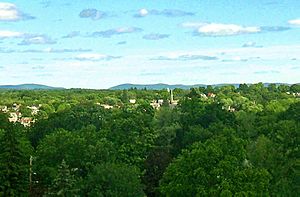
Walden has two schools: the public Walden Elementary School and Most Precious Blood Catholic school.
Walden's Parks and Trails
The village has several public parks and a walking trail for everyone to enjoy:
- Bradley Park is on Albany Avenue. It has 4 baseball fields, 1 softball field, 2 tennis courts, a playground, and a skateboard park. It is home to the Walden Little League.
- Wooster Grove is on East Main Street, surrounded by Tin Brook. It has a large playground, indoor and outdoor basketball courts, a bandstand, and an ice rink. The village's teen center is also here.
- James Olley Park is at the end of Sherman Avenue. It has a beach for swimming and fishing, a small playground, a picnic area, and walking trails. It also hosts a summer recreation camp.
- Alfred Place Park is the only park on the west side of the village. It has a small playground and a basketball court.
- Walden–Wallkill Rail Trail starts at Woosters Grove. It is a 3.22-mile (5.18 km) paved trail for walking and biking. It connects Walden to the hamlet of Wallkill in Ulster County.
Most of the rest of the village is residential. Houses range from smaller homes near downtown to larger Victorian homes on the hills. There are also 6 small apartment and townhouse complexes.
Walden's Climate
Walden has a humid continental climate. This means it has warm summers and cold, snowy winters. It tends to be cooler than Manhattan, especially at night.
| Climate data for Walden, New York (1981–2010 normals) | |||||||||||||
|---|---|---|---|---|---|---|---|---|---|---|---|---|---|
| Month | Jan | Feb | Mar | Apr | May | Jun | Jul | Aug | Sep | Oct | Nov | Dec | Year |
| Mean daily maximum °F (°C) | 34.0 (1.1) |
37.6 (3.1) |
46.4 (8.0) |
59.0 (15.0) |
69.6 (20.9) |
78.1 (25.6) |
82.5 (28.1) |
81.1 (27.3) |
73.7 (23.2) |
62.3 (16.8) |
50.9 (10.5) |
38.8 (3.8) |
59.5 (15.3) |
| Mean daily minimum °F (°C) | 14.4 (−9.8) |
16.9 (−8.4) |
25.5 (−3.6) |
36.3 (2.4) |
46.0 (7.8) |
55.5 (13.1) |
60.0 (15.6) |
58.5 (14.7) |
49.9 (9.9) |
37.8 (3.2) |
30.5 (−0.8) |
20.9 (−6.2) |
37.7 (3.2) |
| Average precipitation inches (mm) | 2.97 (75) |
2.61 (66) |
3.65 (93) |
3.84 (98) |
4.15 (105) |
4.42 (112) |
4.05 (103) |
3.93 (100) |
4.09 (104) |
4.12 (105) |
3.56 (90) |
3.43 (87) |
44.82 (1,138) |
| Average snowfall inches (cm) | 13.3 (34) |
10.6 (27) |
8.1 (21) |
1.3 (3.3) |
0 (0) |
0 (0) |
0 (0) |
0 (0) |
0 (0) |
0 (0) |
1.3 (3.3) |
8.9 (23) |
43.6 (111) |
| Average precipitation days (≥ 0.01 in) | 9.6 | 7.9 | 9.7 | 10.8 | 11.7 | 10.9 | 10.0 | 9.9 | 8.5 | 8.8 | 9.1 | 9.3 | 116.2 |
| Average snowy days (≥ 0.1 in) | 4.9 | 3.6 | 2.8 | 0.5 | 0 | 0 | 0 | 0 | 0 | 0 | 0.6 | 2.8 | 15.2 |
| Source: NOAA | |||||||||||||
Walden's Population and People
| Historical population | |||
|---|---|---|---|
| Census | Pop. | %± | |
| 1870 | 1,254 | — | |
| 1880 | 1,804 | 43.9% | |
| 1890 | 2,132 | 18.2% | |
| 1900 | 3,147 | 47.6% | |
| 1910 | 4,004 | 27.2% | |
| 1920 | 5,493 | 37.2% | |
| 1930 | 4,283 | −22.0% | |
| 1940 | 4,262 | −0.5% | |
| 1950 | 4,559 | 7.0% | |
| 1960 | 4,851 | 6.4% | |
| 1970 | 5,277 | 8.8% | |
| 1980 | 5,659 | 7.2% | |
| 1990 | 5,836 | 3.1% | |
| 2000 | 6,164 | 5.6% | |
| 2010 | 6,978 | 13.2% | |
| 2020 | 6,818 | −2.3% | |
| U.S. Decennial Census 2020 | |||
In 2020, there were 6,818 people living in Walden. These people lived in 2,466 households. The average household size was about 2.76 people.
Most of the people in Walden are white (77.3%). There are also African American (13.7%), Native American (2.9%), and Asian (3.1%) residents. About 23.4% of the population is Hispanic or Latino. Many of the Hispanic or Latino residents are of Puerto Rican origin.
About 23.1% of Walden's population is under 18 years old. About 12.9% are 65 years old or older. The average age in Walden is 36.2 years old.
The average household income in Walden is about $76,724 per year. The average family income is about $103,672 per year. About 17.6% of Walden's population lives below the poverty line.
Walden's Economy and Jobs
For 95 years, Walden was home to Spence Engineering. This company made steam regulators. It was bought by Emerson Electric in 2019 and later moved its operations.
Even though the knife factories are gone, other light-industrial businesses still exist along the train tracks. The growing service sector is strong, with two local banks: Walden Federal and Walden Savings Bank.
Shopping has always been important in Walden. Thruway Markets opened in 1955. It was a supermarket and a large store for many items, like a big box store. This store brought many shoppers to Walden, even from other towns. In 2013, the supermarket part of Thruway Markets was sold to Hannaford, a new supermarket was built, and the Ace hardware store reopened.
Some empty spaces remain on Main Street, but special stores and restaurants are doing well there. Millspaugh Furniture is another popular store that brings shoppers from outside Walden. It is known for its long history and quality items.
Many Walden residents work in the local area. The nearby interstate highways offer jobs in transportation and distribution. This includes places like the Yellow Freight facility and the large Staples warehouse. Local and state government agencies also employ residents. More recently, people living in newer homes in Walden often travel to jobs in New York City or nearby areas.
Transportation in Walden
Walden is served by two state highways and two county roads. Route 52 goes east to west. It connects Walden to Newburgh to the east and Pine Bush to the west. NY 208 goes north to south. It connects Walden to Wallkill to the north and Maybrook to the south. These two roads briefly share a block in the center of town.
Most traffic coming from outside the area uses Route 208 from the south. This is because it has an exit on Interstate 84 about 5 miles (8 km) south of the village. County roads 23 (River Road) and 75 (Coldenham Road) also connect to other nearby towns.
A train track, part of the old Wallkill Valley Railroad, still serves some businesses in Walden. There have been talks about starting commuter rail service from Walden to New York City using the Metro-North Port Jervis Line. The closest passenger train station is currently Campbell Hall. You can also catch a Metro-North train to New York City from Beacon, across the Hudson River from Newburgh. Amtrak trains stop in Poughkeepsie.
The closest airport for small planes is Orange County Airport, south of Montgomery. For larger commercial flights, people use Stewart International Airport.
Short Line buses also serve Walden on their route between Newburgh and Middletown.
Education in Walden
Walden is part of the Valley Central School District (Montgomery).
Images for kids
See also
 In Spanish: Walden (Nueva York) para niños
In Spanish: Walden (Nueva York) para niños



